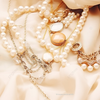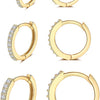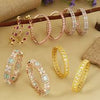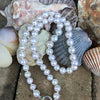A Journey into the History of Jewelry
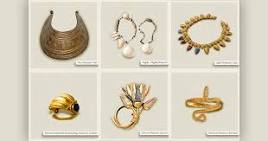



The Middle Ages saw a shift towards more symbolic jewelry. Crosses, pendants depicting saints, and signet rings bearing family crests became commonplace. Precious metals and gemstones like diamonds and rubies were reserved for the Royals and nobility, while the burgeoning merchant class embraced more elaborate and flamboyant designs. The use of silver and enamel became prominent, adding vibrant colors to jewelry because of its availability.
Renaissance Elegance:

The Renaissance brought a renewed focus on classical forms and motifs. Jewelers drew inspiration from ancient Greek and Roman designs, incorporating cameos, scrolls, and mythological figures. Techniques such as filigree and repoussé gained popularity, allowing for more intricate and delicate pieces. Gemstones were cut and polished to maximize their brilliance, creating pieces that were both opulent and technically masterful. Jewelry became a status symbol and a means of showcasing one's wealth and refinement.
Baroque Extravagance:

The Baroque era was characterized by opulence and grandeur, and jewelry mirrored this trend. Large, bold pieces adorned with diamonds, pearls, and colorful gemstones were in vogue. Baroque jewelry often featured intricate detailing, asymmetry, and a sense of movement, reflecting the exuberance of the time.
Modern Transformations:

The Industrial Revolution ushered in a new era of jewelry production, a revival of historical styles, with jewelry taking inspiration from various periods. Mass-production techniques made jewelry more accessible The Victorian era, in particular, saw a wide range of designs, from sentimental lockets to elaborate mourning jewelry. The discovery of new gem deposits, such as diamonds in South Africa, led to innovative cutting techniques and a surge in popularity.
Art Nouveau and Art Deco:

The turn of the 20th century brought about two distinct styles in jewelry design. Art Nouveau embraced flowing, organic forms inspired by nature, while Art Deco favored geometric shapes and bold colors. Both movements left an indelible mark on jewelry design, influencing pieces that are still celebrated today. The 20th century saw the rise of iconic jewelry houses like Cartier and Tiffany & Co., shaping trends and setting new standards for luxury.
-
Posted in
#AdornmentJourney, #ClassicJewelry, #CulturalAdornment, #CulturalJewelry, #ElegantAccessories, #ElegantChain, #EverydayElegance, #FashionAccessories, #ForeverLove, #HeritageJewelry, #HistoricalJewelry, #JewelryAddict, #JewelryEvolution, #JewelryForEveryOccasion, #JewelryHeritage, #JewelryInspiration, #JewelryOrigins, #JewelryPassion, #JewelryTrends, #MeaningfulJewelry, #MinimalistJewelry, #ModernJewelry, #StyleStatement, #StyleTips, #StyleWithStory, #StylishJewelry, #SymbolicJewelry, #SymbolOfLove, #TimelessAdornment, #TimelessBeauty, #TimelessElegance, #TimelessJewelry, #VersatileJewelry, Casual, Chokers, fashoin, Glitz Design, Jewelry, necessity, PAVOI, Pendant Necklaces





